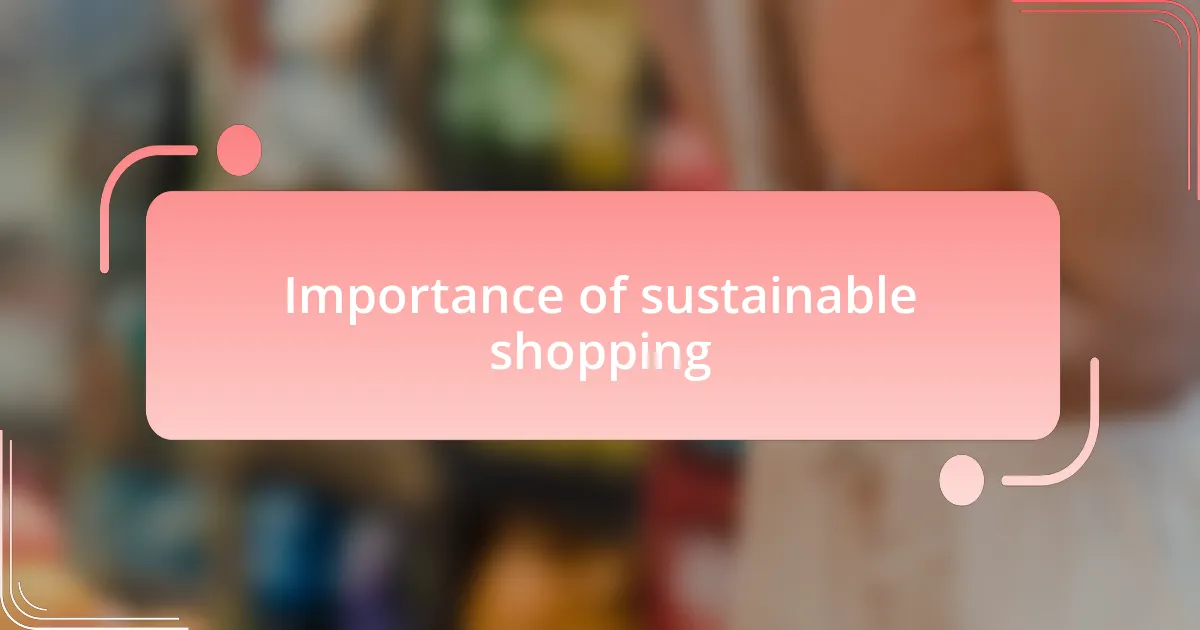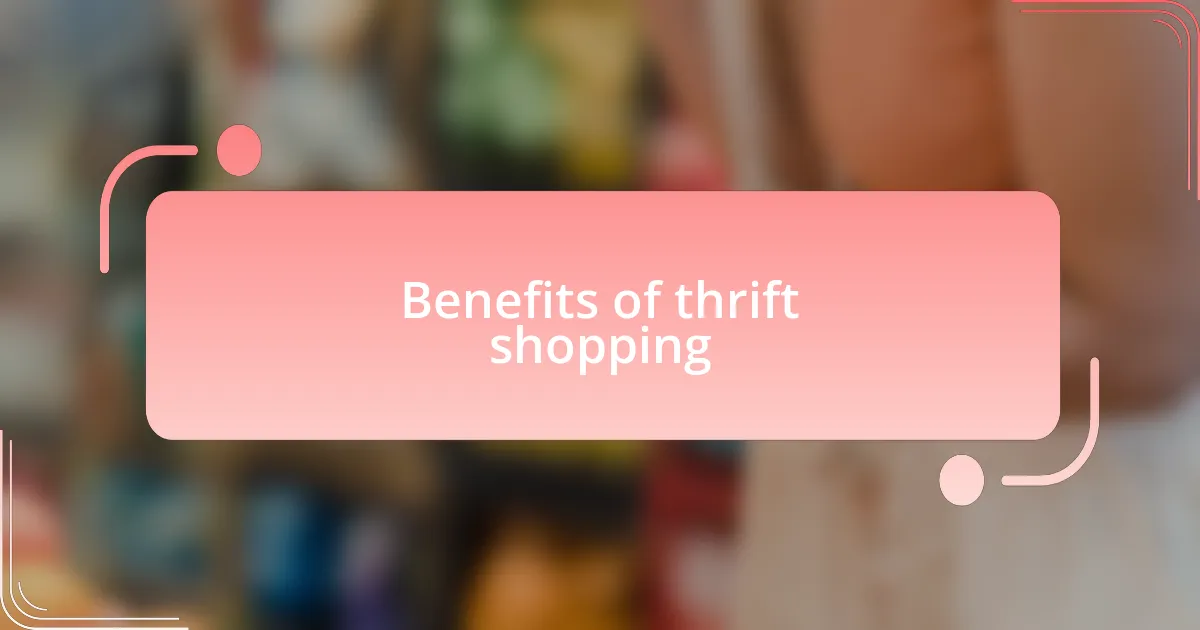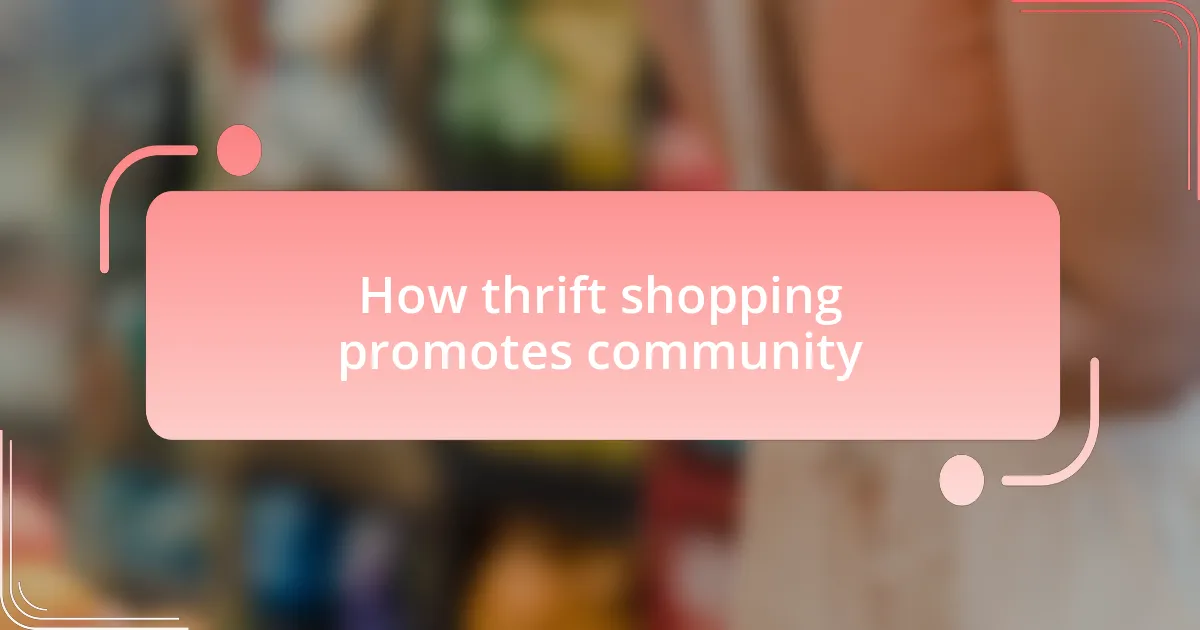Key takeaways:
- An ethical marketplace emphasizes transparency and connects consumer purchases to social and environmental values.
- Sustainable shopping reduces waste and supports local economies, allowing consumers to challenge fast fashion’s negative impact.
- Thrift shopping fosters individuality by offering unique items, creating personal connections, and enhancing community ties through shared experiences.
- Success in thrift shopping relies on open-mindedness, regular visits to stores, and careful evaluation of items for quality.

Understanding ethical marketplace concepts
An ethical marketplace thrives on transparency, where consumers can connect their purchases to the values they hold dear. I remember feeling a surge of satisfaction when I found a vintage jacket at a local thrift store, knowing that my purchase supported both sustainable practices and a circular economy. Have you ever had that moment where you realize your small choice can ripple out to create larger positive impacts?
Understanding ethical concepts means recognizing the difference between consumerism and conscious consumption. Thrift shopping, for me, became a way to redefine my relationship with fashion and material goods. It wasn’t just about finding unique items; it was about embracing a lifestyle that reduces waste and challenges fast fashion’s detrimental effects. Can a wardrobe filled with pre-loved pieces truly tell a deeper story than one brimming with trendy labels?
Moreover, ethical marketplaces often prioritize fair labor practices. When I volunteer at a local charity shop, I see firsthand how every sale aids a cause, enriching lives in our community. This connection makes me wonder—how can our shopping choices not only reflect our tastes but also our commitment to social and environmental well-being?

Importance of sustainable shopping
Sustainable shopping is crucial because it empowers consumers to make choices that positively impact the environment. When I stroll through a thrift store, I often reflect on how each item contributes to reducing waste. Isn’t it fascinating to think that by purchasing a second-hand shirt, I’m not just acquiring a new piece but also helping to decrease the demand for new production, which in turn benefits our planet?
Embracing sustainable shopping allows us to challenge the fast fashion industry, notorious for its harmful environmental footprint. I recall an eye-opening documentary revealing the catastrophic effects of textile waste, which made me consider how many clothes I truly need. Could shifting to thrift shopping transform our perspective on necessity and abundance, enabling us to embrace creativity over consumerism?
Additionally, supporting sustainable practices often means investing in local communities and economies. When I buy from thrift shops, I appreciate knowing my money stays in the area, supporting local charities and businesses. How empowering is it to realize that our shopping habits can cultivate a vibrant community, nurturing connections beyond just the exchange of goods?

Benefits of thrift shopping
Thrift shopping offers a unique opportunity to save money while uncovering hidden treasures. I still remember the thrill of finding a vintage leather jacket for a fraction of its original price. It’s like a mini adventure each time I enter a store—wondering what rare item I might discover and how it might add personality to my wardrobe without breaking the bank.
Another benefit that really resonates with me is the thrill of sustainability. Every time I choose an item from a thrift store, I feel a sense of pride knowing I’m making a conscious decision to reduce waste. Isn’t it a rewarding feeling to know that I’m not only adding to my collection but also actively participating in a cycle that respects the environment?
Moreover, thrift shopping promotes a unique sense of individuality. Each piece tells a story, and it’s always enjoyable to think about the journey that item has been on before reaching my hands. Who wouldn’t want to own a sweater that has its own history, sparking conversations and connections? In a world flooded with mass-produced clothing, seeking out second-hand pieces makes our outfits distinctive and reminds us of the beauty of personal expression.

Personal experiences in thrift shopping
Stepping into a thrift store is like entering a treasure trove, where every aisle offers surprises. Just last week, I stumbled upon a quirky piece of decor—a vintage globe with a worn surface. I couldn’t help but wonder about the stories it could tell, which brought a warm nostalgia that I haven’t felt in a long time. Each discovery evokes a sense of connection to the past, making me appreciate the craftsmanship of earlier eras.
On another occasion, I found a perfectly tailored blazer that fit like it was made for me. I still recall the moment I put it on; it felt like a small win. It’s amazing how clothing can boost our confidence, and thrifting allows me to find unique pieces that make me feel empowered without feeling guilty about the spending. Have you ever had a moment where an outfit just clicked? That’s the magic of thrift shopping.
Thrift shopping isn’t just about the items; it’s about the experience. I remember attending a local thrift fair where I met the kindest vendors, passionate about sustainability. Their enthusiasm was contagious, and it made me realize that I’m part of a larger community. Sharing those moments and stories gives me a sense of belonging that I find deeply fulfilling. Isn’t it incredible how a simple shopping trip can forge connections?

Tips for successful thrift shopping
Finding success in thrift shopping often comes down to being open-minded. I remember walking into a store with no specific item in mind, just a willingness to explore. As I scanned the racks, I discovered a pair of vintage shoes that weren’t my usual style but intrigued me nonetheless. It’s these unexpected finds that can often lead to the most interesting additions to our wardrobes. Have you ever taken a chance on something outside your comfort zone? Sometimes, that risk pays off in wonderful, stylish surprises.
Another trick I’ve learned is to visit regularly. I try to drop by my favorite thrift shops every few weeks, as their inventory changes frequently. On one such visit, I found a charming ceramic vase that caught my eye right away. It turned out to be a unique piece, and I still cherish it. Regular visits help you build a rapport with the staff, too; they often share insider tips on upcoming sales or new arrivals. Plus, familiarity with the layout helps you navigate the store more efficiently. How can you not get excited about that?
Lastly, it’s crucial to evaluate items carefully before purchasing. I can recall a beautiful dress that I almost bought but later noticed had a small tear. That’s a lesson I learned the hard way; while thrifting offers great deals, it’s essential to ensure the pieces are in good condition. Ask yourself: is the item worth the investment of time and potential repair costs? This sort of mindfulness not only enhances your thrift shopping experience but also supports a more sustainable approach to fashion. Have you taken a moment to inspect a hidden gem closely? It might just lead to your next favorite find.

How thrift shopping promotes community
Thrift shopping has a wonderful way of bringing people together, both through shared experiences and communal spaces. I once met a fellow shopper at a thrift store who was also passionate about reducing waste. We bonded over our love for sustainable fashion and ended up exchanging tips on our favorite finds. Moments like these remind me that thrift shops can be a hub for like-minded individuals, fostering connections that extend beyond the shopping experience.
Additionally, many thrift stores support local causes and charities, which highlights their role in community development. I often see signs posted around the store, detailing how each purchase contributes to local initiatives. Knowing that my money is supporting such vital work warms my heart. It’s empowering to shop with a sense of purpose, as every purchase helps create a positive impact in the community, enhancing the overall sense of belonging.
Community events, such as swap meets or themed sales, often take place in thrift shops, allowing locals to connect in creative ways. I once attended a vintage clothing swap at my favorite shop, and the atmosphere was electric. Everyone came together to share their styles while enjoying good conversation. Have you ever participated in a similar event? These gatherings not only celebrate sustainable fashion but also strengthen community ties, proving that thrift shopping is truly more than just a shopping trip – it’s a shared journey.